Winter care for herd bulls
https://www.agproud.com/articles/62272-winter-management-of-herd-bulls-the-forgotten-investment
shared by P Baker
Winter care for herd bulls Read More »
Herd Health”With the rise of farm-to-table eating and artisanal meats many diners are seeking out flavorful beef from non-commercial cattle breeds. One such breed gaining popularity is Dexter beef a tender, succulent meat from small, hardy cows native to Ireland.”
https://redtablemeats.com/fresh-meat/beef/what-is-dexter-beef
What is Dexter Beef? Read More »
BeefThe mama is #116 Briarhook Juno Legacy # L03860LH-19HH and bull calf born September 29 with Fitz’s Golden Legacy Dillen. Dillen is our current sire, and he is the progeny of Colorado Chief and Chautauqua Demelza.
About the author…
Angie Gaines grew up in the Sandhill Piedmont of North Carolina. As a child she accompanied her grandpa to cattle auctions. They raised feeder stock in the wonderful sandy loam. Her mother and father raised registered Polled Hereford cattle and their favorite standing bull was called Jerry Justin Banner 3rd. Almost twenty years ago Angie decided to be part of the preservation of the Irish Dexter cattle loved in Ireland. When she shared a photo of her beginning herd her mother aged 78 exclaimed; “Wow, look at those horns”. Angie responded with “ Mama, if a cow wants to hurt you they don’t need horns to do it”. Angie now resides in Texas with her wonderful Irish Dexters and Curly Mustangs.
====================
I gaze out my window on a rainy day and see three beautiful Black horned Irish Dexter cows, Juno, Flora and Faye grazing on the lush Spring grass in the Lone Star State. I wonder what it was like when their ancestors grazed just outside a little hamlet known as Argyle about 100 miles Northwest of Dallas, Texas of me. Their ancestors were the foundation for a line of Irish Dexter cattle that 50 years later would be known as the Legacy “Colorado” line and I am intrigued that these wonderful cows have made an interesting journey back to Texas.
“Mark and Marge (Davis) were living in Colorado when they first read about little cows known as Irish Dexters. Mark borrowed a trailer and traveled to Argyle, Texas to purchase his first cow and calf and a 14-month old heifer. ‘The cow was milking, but she was very wild”, he said with a chuckle. “A rancher friend of ours taught me to milk.” The couple later purchased a herd bull from Decorah, Iowa and in 1966, they and 5 cattle moved to Delaware. Mark Davis was a past President of the American Dexter Cattle Association.” He was also the Delaware registered agent for PDCA incorporation until recently.
The oldest Colorado cow owned by Mark and Marge Davis listed in our wonderful resource the Legacy Irish Dexter Registry is Colorado Queen (circa 1967). She goes back to Lady Knight who was bred by Dr. Harvey Goettsche in Dallas, Texas and Edmonde LeRoux, Argyle, Texas. Dr. Goettsche, was a well-known dentist who enjoyed the ranching life as a hobby. His partner Edmond LeRoux, had a beautiful ranch in Argyle, Texas and was a retired American Airline pilot with an impressive history of helping U.S. troops fly to destinations including the Far East, Japan, Australia and more with the Military Airlift Command and American Airlines.
Lady Knight has awesome ancestors who are beloved in our Irish Dexter community including Grinstead and Peerless. She is also the dam of the well-known bull Colorado Chief whose sire was an Irish Dexter bull Mark Davis went to Iowa to and brought back to Colorado. Marge Davis shared this in a phone conversation. She shared the wonderful journey that has become the foundation for the Colorado herd.
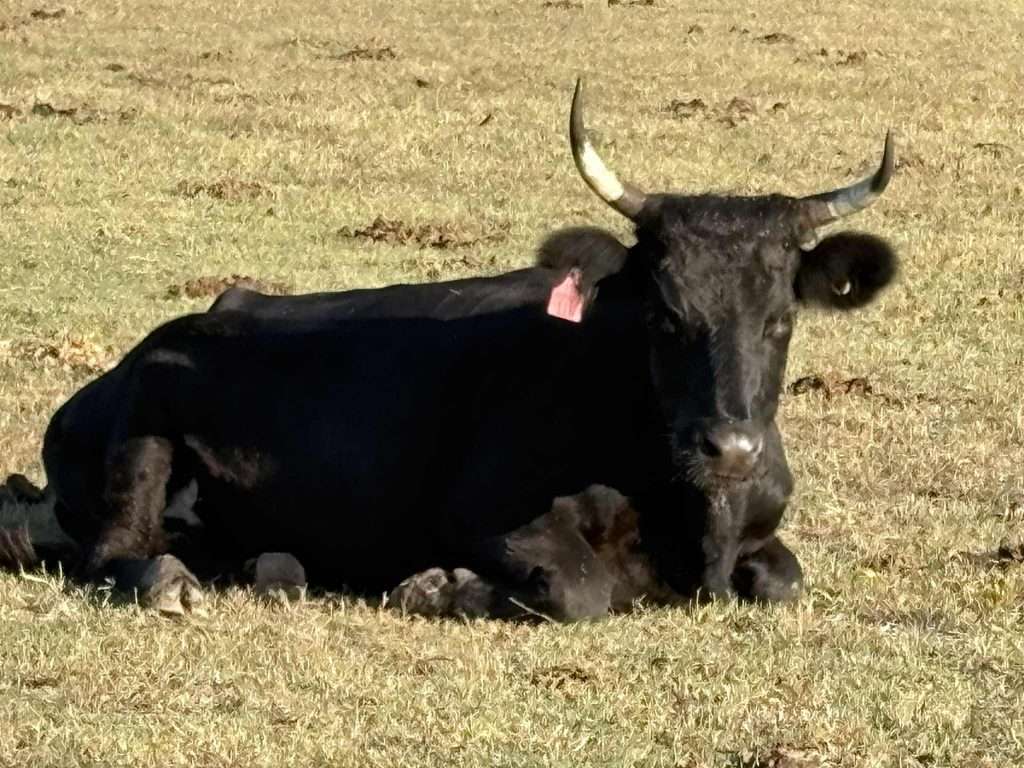
Since we have explored how Lady Knight and her heifer left Argyle, Texas and became the foundation of the wonderful Colorado herd, let’s go back and explore how the Irish Dexter cattle came to be found in Texas. Lady Knight was the progeny of a nice bull registered as Captain Fortune and bred by Otto C. Jensen. Captain Fortune’s ancestors were direct registered cattle from the Peerless herd. “The foundation for the Peerless herd at Decorah, Iowa, was obtained by John Logsdon from the Elmendorf Farm, August A. Busch and James J. Hill, in 1919. Later, two bulls were obtained successively from Daniel Guggenheim, owner of Hempstead House herd. In 1944, when the Peerless herd had their first public sale, the herd numbered 150 head of cows and heifers! Peerless herd is the oldest Dexter herd in the United States. “ (Remember the Busch name as we continue this journey through history.)
With the tireless work, Judy Sponaugle has put together a researchers dream, creating the Legacy Irish Dexter Registry. Within a few short strokes on my keyboard and a quality internet connection, I am able to see that Lady Knight’s dam was the beautiful Black Duchess who was born in 1958. Edward Lord bred her with Atlantic Cornelius as her sire and Framfield Roda 7th as her dam. Both of Lady Knight’s parents were registered in the Dexter Cattle Society (DCS) founded in the United Kingdom. Both Atlantic and Framfield’s dams were the well-lovedGrinstead dams and going back till the beginning of the DCS (Dexter Cattle Society) conception circa 1892.
Back to the Lone Star state, we find a handsome Black Bull named Mark Anthony. His parents are Black Duchess and Atlantic Cornelius. His owner and breeder is a well know colorful character in the history of Texas, Clint Murchison. In my search, I have found little documentation about Irish Dexters, but it was well known that Mr. Murchison loved ranching. Ernestine Orrick Van Buren points out in her book Clint: Clinton Williams Murchison: A Biography : “In the late 1930s Murchison began diversifying his investments. He acquired numerous life-insurance companies, banks, bus lines, publishing firms, heavy industrial building materials companies, and an assortment of companies serving such leisure activities as hunting, fishing, travel, and gardening. He was a cattleman throughout his life and acquired extensive ranches in Mexico and East Texas. He experimented in improving cattle strains and in developing superior grazing grasses.”
Yes, millionaires loved our Irish Dexters, too! Speaking of millionaires let’s go back and visit the Anheuser Busch family and their involvement in Irish Dexter cattle and Texas. I ran across a 1916 newspaper article from Waco, Texas where 14 Irish Dexters belonging to Anheuser Busch Dexter Cattle. The cattle was transported via train to show their exhibit known the Bevo during a “tick” quarantine. The event appears to have hugely popular. We do know from well-kept records that , “In 1914, August A. Busch of St. Louis, Missouri purchased Dextersfrom C.D. Gregg of St. Louis and established the Grant’s Farm Herd. Additional animals were purchased by August Busch in 1915 from Elmendorf Farm in Lexington, Kentucky. The Elmendorf Herd was dispersed in 1917.” Perhaps a few of these wonderful cows stayed in Texas.
The Colorado herd of Irish Dexter cattle that Mark and Marge Davis created has an amazing history and enjoyed passage with many friends they encountered along the way. I feel fortunate to be friends with those who continue this line of Irish Dexters including Judy Sponaugle (owner of the Legacy Registry and Preservation Project ), The Mendenhalls, Lori Goldman and several others. I am especially grateful to Pam Baker, for the opportunity to add Juno, Flora and Faye in our herd and welcome them back to the Lone Star state where their ancestors once roamed.
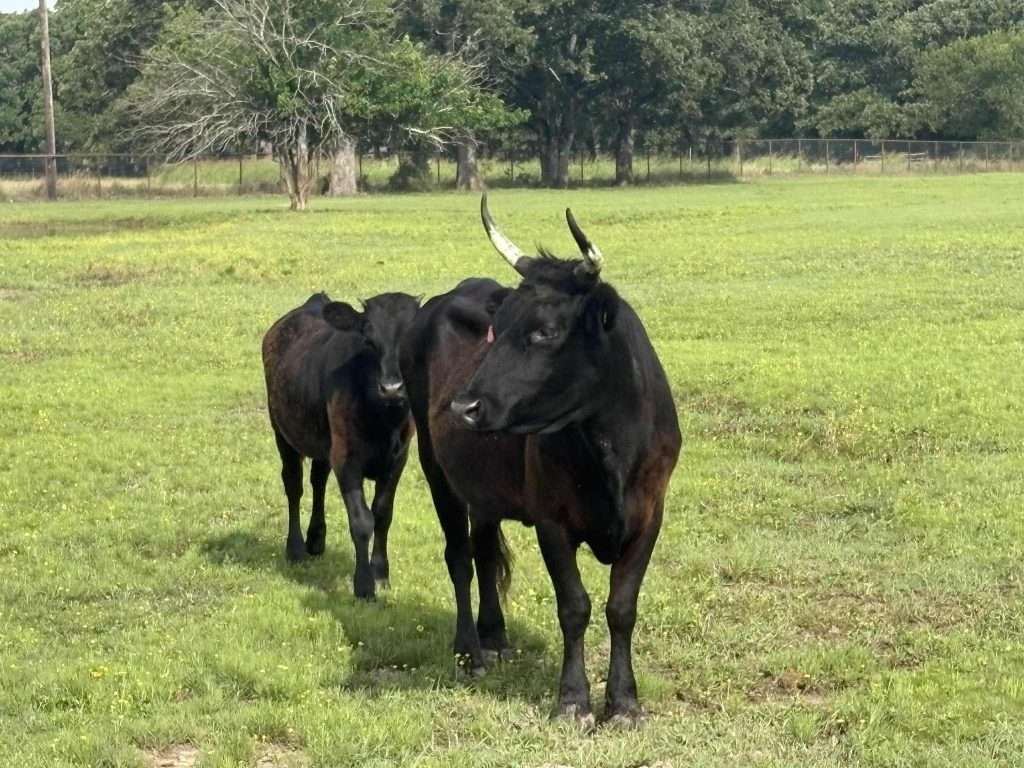

Dexters are well known as Irish Dexters even if many other points about them are debated. The above bull though registered with the Dexter Cattle Society is an Irish Dexter with a “fine type and constitution” as the article states. I checked, he certainly was owned and breed by Mr. W. Lindsay Everard of Ratcliffe. This article holds true to the fact that Dexters are known to be of a small type of cattle. That very small cattle were known to roam Ireland before “Mr. Dexter” was ever penned in History. In Kerry there was known to be some of the smallest type of cattle one can imagine, long before Dexters were ever established or organized into a true breed. So small of an animal that it is mentioned in this paragraph, but yet still producing 2 gallons of milk a day is a marvel indeed. The brown article was written on 14 Nov 1929, it’s from the Western Daily Press Bristol. The picture was taken from a later newspaper published in 1930. Though the Dexter was well known to produce ample milk and was “closely allied to the Kerry breed and very similar to it in general appearance.” The differences being that “Dexters are “more stoutly built and rounder in their contours”.
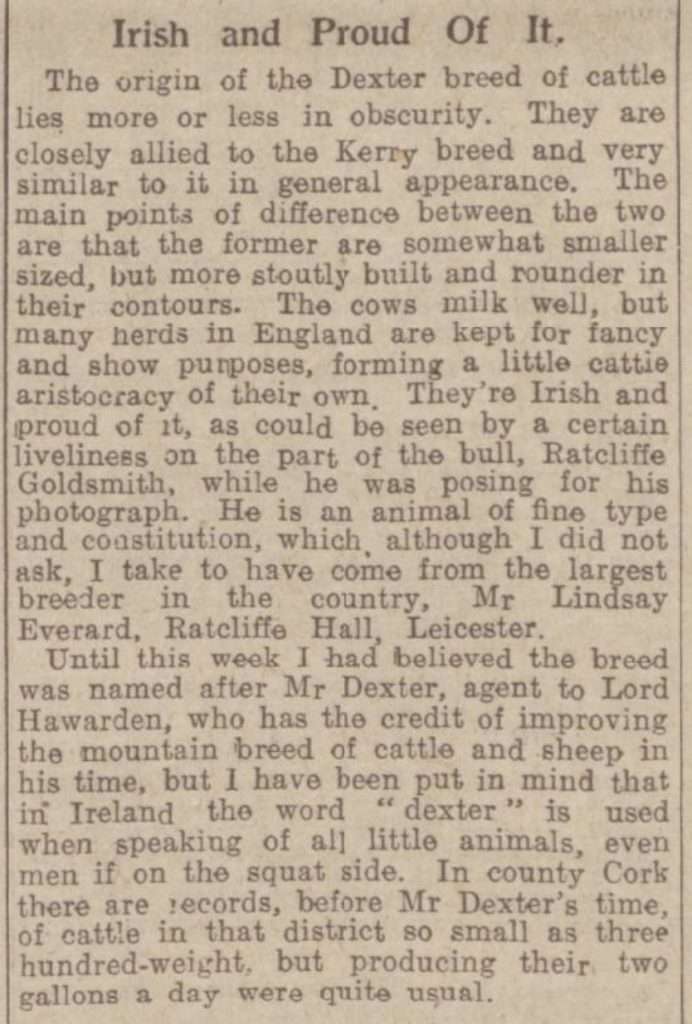
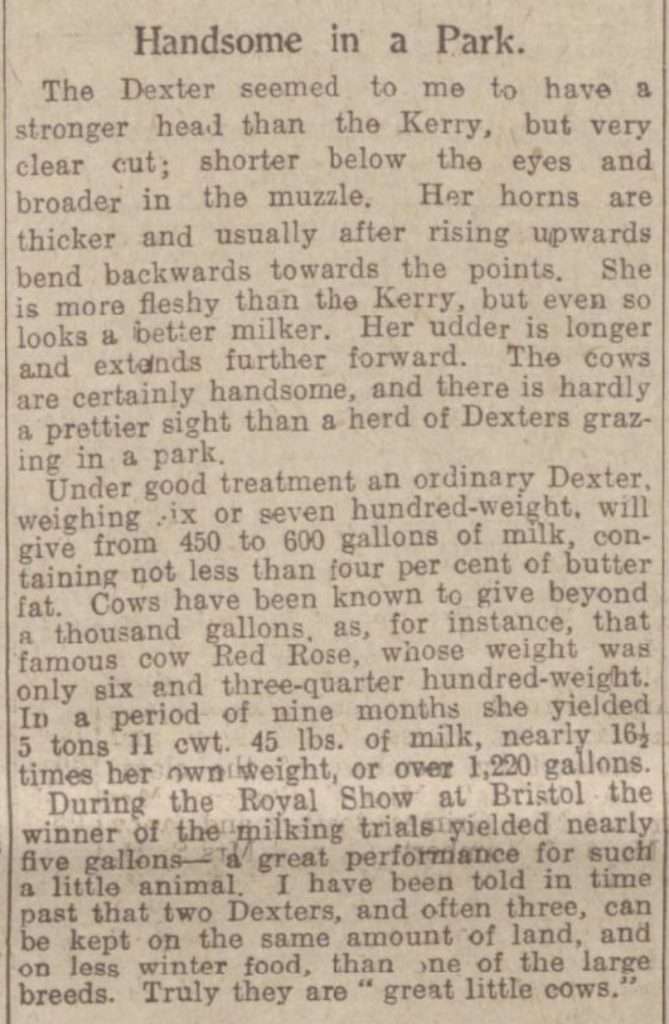
The Dexter has a “stronger head than the Kerry, but very clear cut, shorter below the eyes and broader at the muzzle”. The description of her horns are as follows ” Her horns are thicker and usually after rising upwards bend backwards towards the points”. It is interesting to note that she is even fleshier than the Kerry but was thought to look a better milker than the Kerry. Short cows with large udders seem to showcase the udder in a much more extreme way than a longer legged cow though the udder could be of the same size. The article really goes on to highlight the excellent milking attributes of a Dexter to great lengths. A point worth mentioning is that “there is hardly a prettier sight than a herd of Dexters grazing in a park”. I personally can’t help but look out at my hills and know this rings true to me today, just as much as it must have to the writer of this article in the past! Dexters truly are practical and beautiful when bred for all these amazing Historical traits!

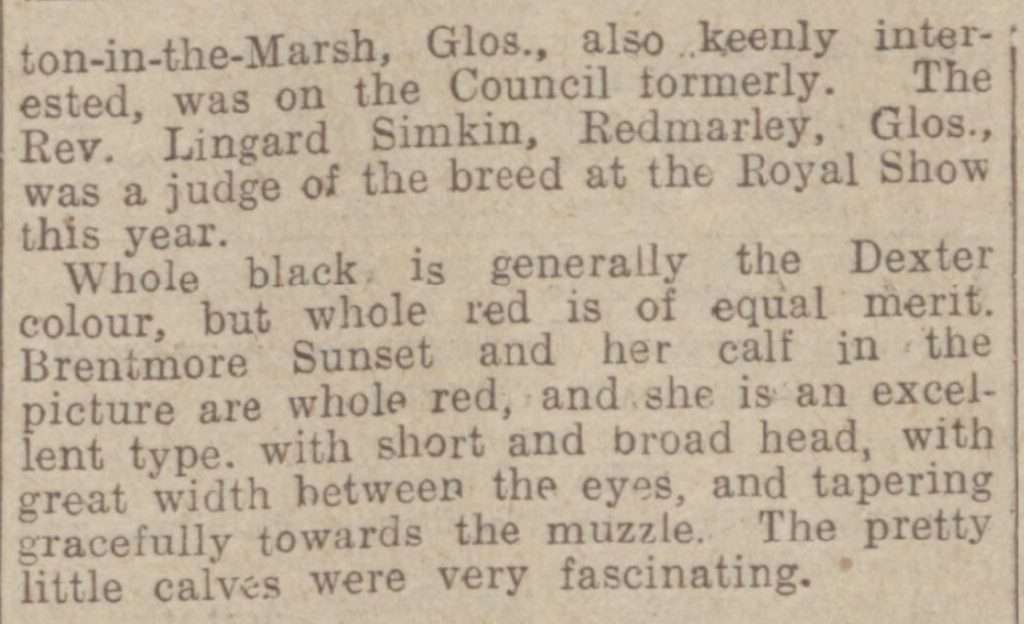
Breeders have long been concerned with breeding to “type” and a few points to mention in this last photo that align with the Standard Description of a Dexter is the color being “Whole black or whole red”. The “Head short and broad” with “great width between the eyes”, and “tapering gracefully twords the muzzle. Dexters definetley impress with their specific beautiful traits and charming ways which took hold of many a wealthy land owner who could aford to buy any exotic cattle they chose. In conclusion Dexters and their “pretty little calves are very fascinating”! They are Irish and Proud of it and those of us who breed them, have been taken by their Irish Charms.
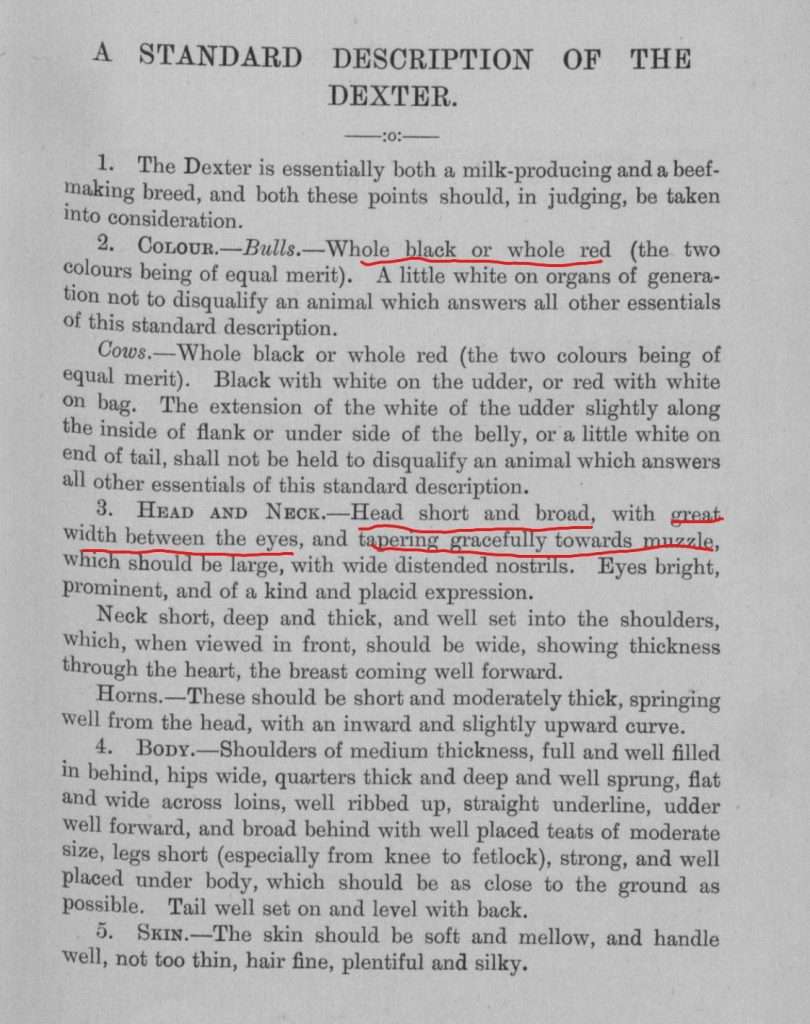
Dexters ARE Irish and Proud of It Read More »
Historical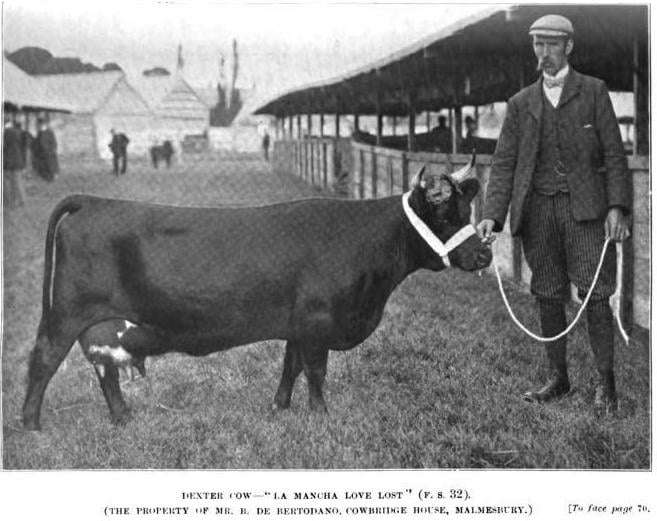
Dexters have long been hailed as hardy and thrifty even adaptable to locations from Africa to snow laden areas. This article I am sharing was written by R. Tait Robertson; he was a famous and most influential Dexter breeder for his day. He was not just any armature Dexter owner, since he was a foundational breeder of Dexter cattle and a generational farmer. He explained that” I have on my farm over 100 of them (Dexters) lying out at present, and they will continue so all winter, getting nothing beyond what they can pick up and a small portion of hay night and morning”. What this means is that Original Dexters could get by on just a little, but of course they could thrive on even more. It was often said that when the Dexters of Ireland went to the manor lands of England they grew greater in size due to the surplus. Dexters can do well on just forage and hay alone with no grain needed. They can excel on the best rations and produce even more, but if times get tough, they can more than get by.
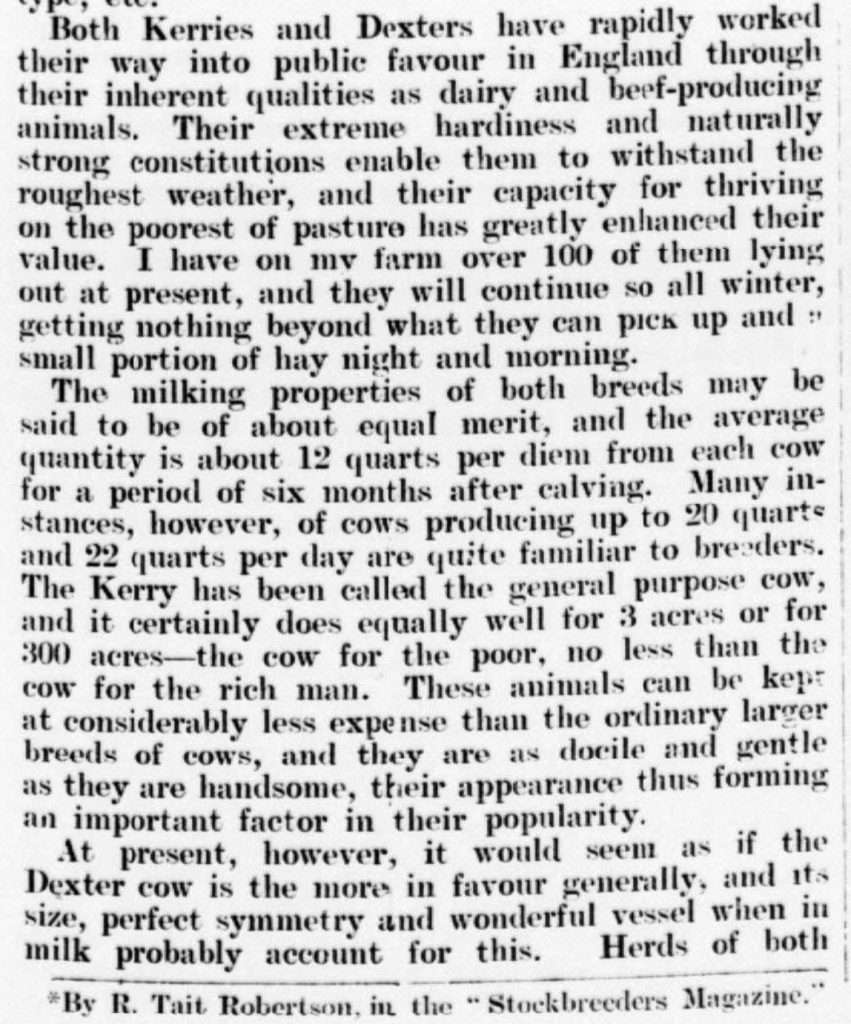
Mr. Roberston was a very influential breeder, breeding in Malahide, County Dublin, Ireland. His family later had Church Farm in Babraham, Cambridge. His Dexters were esteemed as quality and were very sought after by the English who wished to keep them. He is the son of James Robertson. They were not just multigenerational farmers but multi-generational Dexter farmers who helped shape Dexters in their early years by breeding and selection. Dexters as we know them then owed a great degree of tribute to this influential family. Mr. R. Tait Robertson was also a judge for Kerry and Dexter cattle. He judged them by the merit that this article speaks to. Someone may say that Dexters are a beef breed that can milk, but Mr. R Tait Robertson said they have “equal merit” to Kerry cattle. They were not transformed in England to a milking breed but rather selected and bred by breeders like the Robertsons for great dual-purpose traits and were heavy in exceptional dairy traits. When R. Tait Robertson speaks to their equal merit remember that he was a judge for both Kerry and Dexter cattle and those judges gave prizes and entered both Kerry and Dexter cattle into the foundation herd books for the Royal Dublin Society. Dexters are not, nor have they ever been a beef breed that can be milked, but rather a dual-purpose breed with equal merit in milking traits to an ancient breed of dairy cattle (Kerry cattle) that can excel at grass-based feeding.
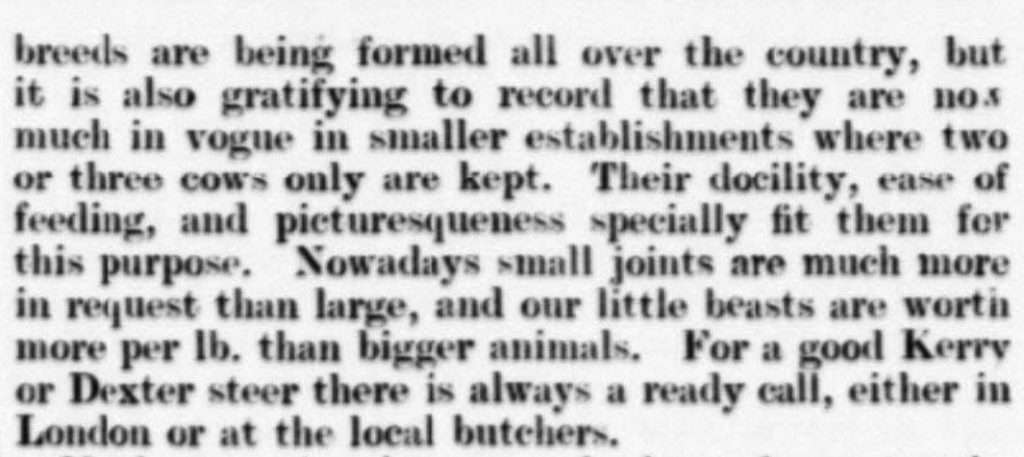
Mr. R. Tait Robertson was the owner and or collector of the cattle in the La Mancha Herd. He or his family may not have bred them all but rather selected some as foundational cattle for the Dexter breed. You will often see La Mancha Dexters registered to him, his father or Robertsons and sons. His Dexters traveled to many countries and those Dexters that could be found “Lying out all winter long, getting nothing more than what they can pick up and a small portion of hay Night and Morning” run in the veins of our Dexters today. This article I shared was written on 16 December 1899 and La Mancha Love Lost was born in 1897. She was qualified by inspection most likely by Mr. R. Tait Robertson and would have spent time in his field while this article was written. It’s nice to think of such a beautiful cow lying out in your pasture all winter long, getting nothing more than what she can pick up and a small portion of hay night and morning then still looking so beautiful! That’s the kind of Dexter I want.
Dwarfing within the Dexter breed is entirely hereditary and does not occur in an individual as a result of a mutation.
Genetics of the Dexter Breed Read More »
HistoricalThis is an interesting article on how people are returning to the old ways and using more and more of their processed beef. Healthier alternatives are growing in your pastures!
https://www.theatlantic.com/health/archive/2025/08/cowmaxxing-wellness-cow-tallow/683826
How much of your Dexter do you use? Read More »
Beef
Mike Baker describes features of market readiness for both finished and unfinished beef and dairy crosses.
Determining the Market Readiness of Beef Cattle Read More »
Beef Herd Health
Learn how to have 1/2 a cow butchered for your family to get the right cuts
Half a beef, What cuts to request Read More »
Beef SellingBy Judy Sponaugle of Legacy
Another registry “innovation” finds the US herd a hodgepodge of mediocre and forgettable initialed herd names. The US is the ONLY country in the world that has so little respect for Dexters they guarantee breeders basic anonymity by using initials of farm names as herd identifiers! Goodness but it IS forgettable.
Here’s an example. I was trying to convince a new breeder about to register a first calf NOT to use the initials encouraged by the US registries for it all but determines anonymity for their herd. Truth be told. . . . there are only two initialed herds in the US I remember by initials, both because the owners were/are prominent in the breed. So, . . . I gave this person examples of wonderful and imaginative herd names, and then I looked at the state of Virginia ( where the owner lived) and picked out three herds with initials. I know most herds and owners by heart through constant research. . . and I looked at the initials and began the process of trying to remember the herds. It was a struggle! One of the herds I knew very well because my own bloodlines founded the herd and it was a perfect example of how even a constant researcher will NOT recognize herd initials. Almost guaranteed anonymity and obscurity unless the person becomes a huge long-term breeder with a large herd.
Woodmagic was chosen by Beryl Rutherford because it was based on a favorite book from childhood, and all her Dexters were named after woodland creatures and birds. Grinstead brings a smile to one’s face, with or without the beautiful photos of that herd and it’s dominance in pedigrees through the years. Most English herds were named after the homes or estates or towns where they grazed. It would be interesting to know the history of the choice of La Mancha for the Robertson family’s Dexter herd, but Round Chimneys leaves little to the imagination. Parndon was a parish in Essex, England, and the origins of Ypsitty is still a mystery to me. My least favorite herd name in the English records is Bryn-y-pin because it was difficult to type.
American herd names prior to the 90’s were also imaginative and memorable. Peerless certainly lived up to it’s identity, and every Missouri Dexter owner would immediately know the roots of “Shome”! Shamrock immediately brings to mind the hallowed green leaf of Ireland, while Rainbow and Rainbow Hills are colorfully soothing to imagine. Talisman is a herd name I always liked, and there is a Virginia herd that lives in literal “Paradise”. The Lone Star and Cascade herds identify their geographic locations but also denote history, and Chautauqua identifies an area of NY where the herd is located. ( Another typing challenge for me).
Then we have SGF and SMD. These herds are owned by long-time well known breeders. Can you immediately identify these herds or do you have to stop and think as I did with a herd I knew as well as my own? In England, or Australia, or even Canada, you would most likely know these herds as Spruce Grove or Silver Maple and the identifier would be far more memorable.
One registry started this and the other continued this nonsense of encouraging owners to use initials and give US Dexter herds guaranteed mundane, boring, and unimaginative herd identifiers. This is an “only in America” tradition that needs to fade into the obscurity IT deserves. Please registrars. . . . STOP . .. . .suggesting to owners to use initials. If you are fairly new to the breed. . . . . then CHANGE those initials to a memorable herd identifier and INSIST on it.
IF. . . you are a new breeder and happen to read this page. . . . . . . . . . . . . your Dexter breeding program deserves a unique identity. I strongly urge you not to be led down the initialed path to anonymity.
THINGS TO CONSIDER ABOUT YOUR HERD IDENTIFIER. A LITTLE BIT OF HISTORY! Read More »
HistoricalThe milking machine market can be so confusing. In an effort to help you wade through what is currently on the market, I created this spreadsheet.
For the budget conscious, make sure that it has a true pulsation, an added bonus is ease of cleaning.
While I have tried to include everything on the market, I am sure I have missed a few.
https://1drv.ms/x/c/c79950faab991348/EUgTmav6UJkggMeSOwAAAAABhxnazfsIBA0-qpk3ObFlAQ
Irish Dexter Cattlemen is about farmers & Ranchers. A critical design feature of the website was to connect farmers & ranchers with each other using the latest technology. For example, whenever you list an item for sale in the MarketPlace, you instantly become connected to the buyers interested in your item. Buyers can directly message you and ask questions about the cow you have just listed. As the seller, you begin to collect the names and email addresses of all your potential buyers. This is one way farmers & ranchers become connected to each other..
Announcing the Documents Vault, a new way farmers & ranchers can share information with other farmers & ranchers, plus a unique way to dramatically simplify the sale and transfer of your Irish Dexter. In fact, you can use the Documents Vault to sell and transfer any item you have on the farm. The key feature is how it can share.


Casual users browsing the Irish Dexter Cattlemen website, users who have registered for free on the website, and members who have registered and then have become members, all have access to the Documents Vault in increasingly feature rich ways depending on their chosen level.
To access the Documents Vault, mouse over Dashboards on the main menubar, then select My Documents Vault. If you are a casual user, this will open the Public Documents Vault containing folders and documents relevant for public viewing. If you are a registered user, this will open your Private Documents Vault where you can create you own personal folders where you can upload files and documents plus you will have acess to folders and files shared with you by other farmers & ranchers. If you are a member, you will have access to the same files and folders as do registered users plus you gain access to significantly more valuable documents that enhance your farming operation.

The Documents Vault is no different than an ordinary file system except in one important way. It provides you with file and documents sharing. To begin, use the New button to create folders or upload files. In this example, a new folder was created and labeled Irish Dexters which you can see on the left under Dashboard. Clicking on this folder allowed for it to be opened and four more folders were created as you see above. Click on the Cows folder and here you can create a separate folder for each of your cows. Click on a specific cow’s folder and you can begin uploading the documents for that cow. What kind of documents? The system accepts Word documents Excel spreadsheets, PowerPoint presentations, text files, pdf documents, images, and photos. This means you can upload a photo of your brucellosis certificate provided to you by your vet. Upload your cow’s registration certificate provided to you by your registrar. Upload the genetic tests provided by your genetics testing lab. Upload your cow’s photos. Collect all the documents as they occur. Use your smartphone to capture your documents. What’s the benefit? When time comes to sell your cow, or heifer, or bull, one simple click of the Share button transfers all your cow’s information to your new buyer. This is how you build value for your farm and your buyer will instantly see that your farm is where they want to buy more cows.
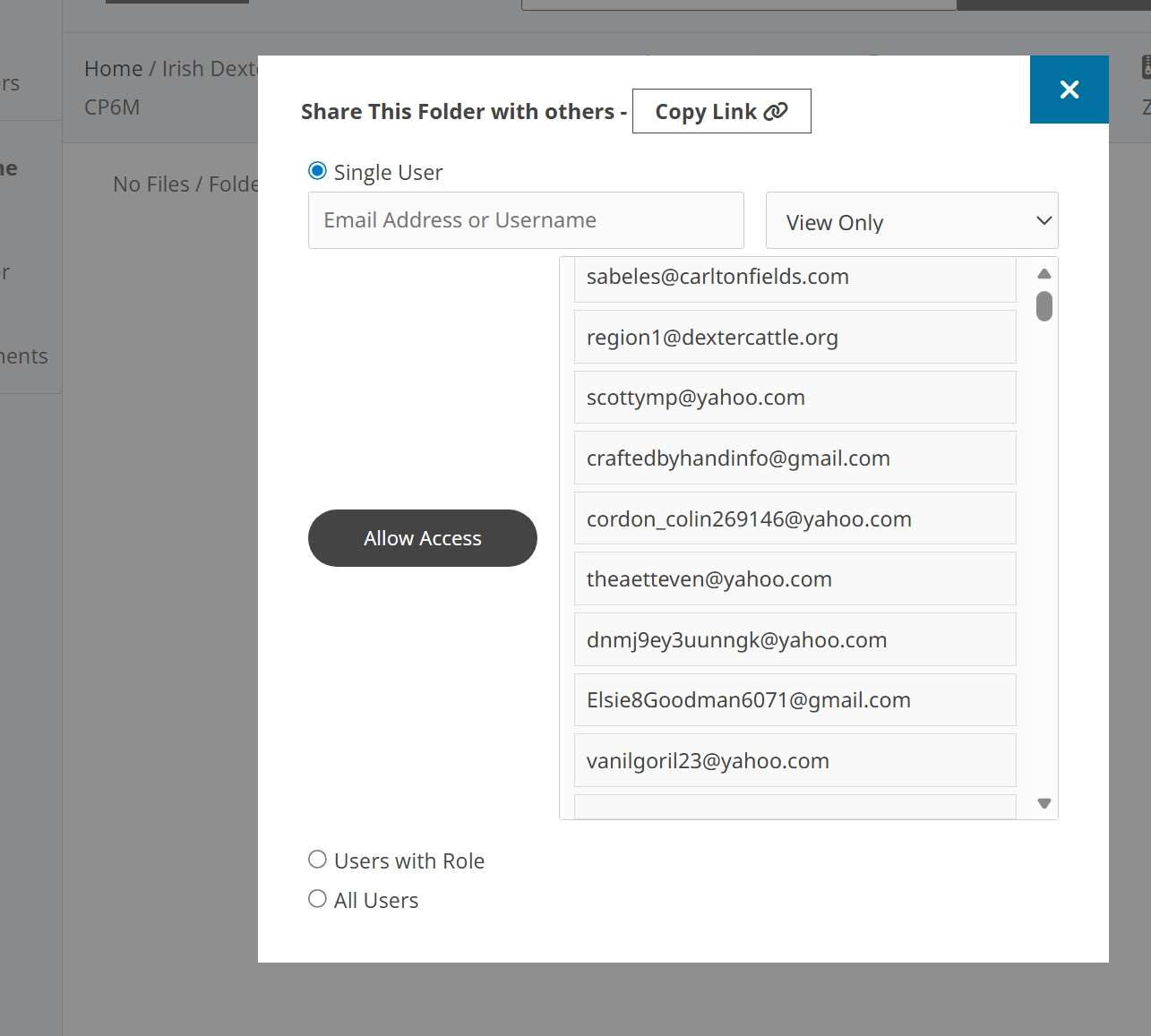
Click on the folder then click on the Share button. It’s as easy as that. In the Share window (shown above) you can enter the buyer’s email address (they must complete a free registration on the website first) and then choose how you want to share your folder. Your choices are View Only, View and Upload, or Full Access. Any folder or for that matter, any single document can be shared. Sharing does not remove the folder or document. You continue to have full access to it, just as before. This new tools makes it even easier to sell and transfer your Irish Dexters and you have a direct record of who bought your cow. They buyer has a direct record of where they bought each animal. They are sure to buy more from you again.
Your fundamental, underlying goal in the operation of your farm is to build value. The Documents Vault does just that. It keeps you organized and it demonstrates to your buyers a significantly higher degree of trust. They are assured that they get everything they bought. This means that your buyers will be contacting you first for all their future purchases. The example here was for your Irish Dexters, but anything on your farm can be documented and shared in the same way. Also, you can add new information on how you farm and capture information you think is valuable and easily share it with everyone at Irish Dexter Cattlemen by selecting All Users in the Share window. The Documents Vault is how Irish Dexter Cattlemen connects farmers & ranchers.
Announcing The Documents Vault Read More »
GeneralHere is a great video from Greg Judy about the benefits of grazing cattle through snow. He includes tips on keeping water from freezing, looking out for parasite issues, and keeping your operation profitable.
Grazing Through Snow Read More »
Farm ManagementMany thanks to Judy Sponaugle of the Legacy Registry for providing the Irish Dexter Cattlemen with this valuable information. This is the first in a series of excerpts from The American Kerry and Dexter Cattle Club.
It is a great find for all you Dexter history buffs! Seeing some of the old advertisements and recognizing some of those herds was a thrill for me.
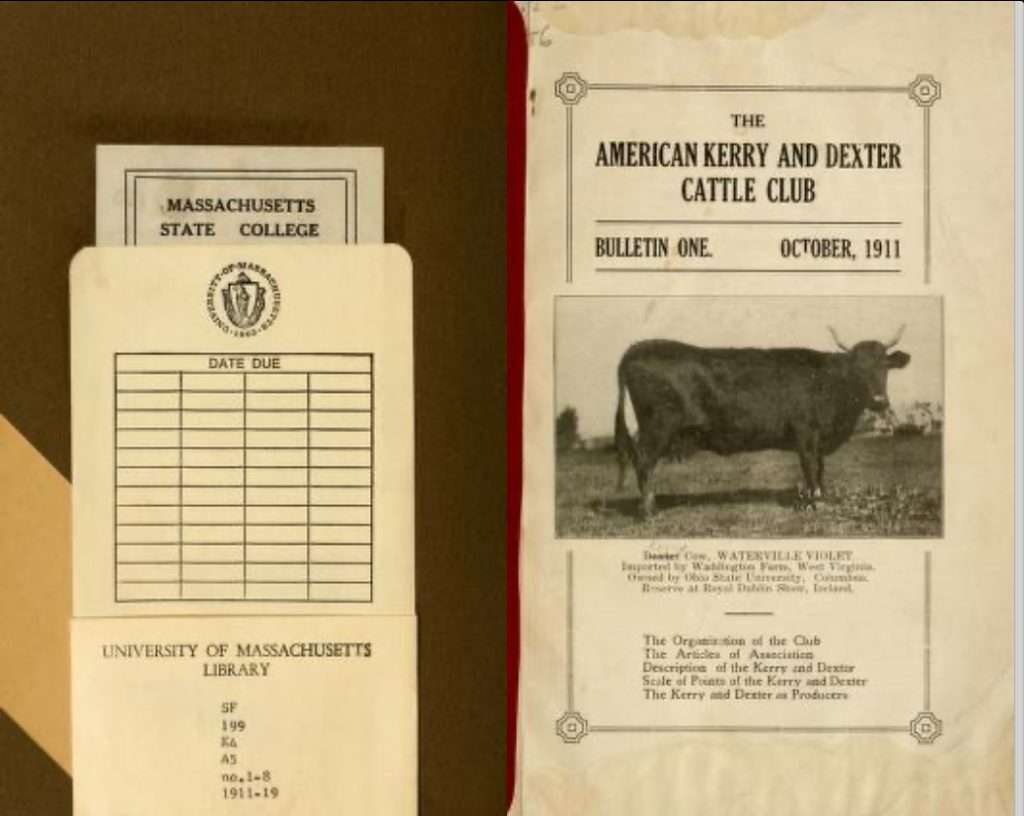
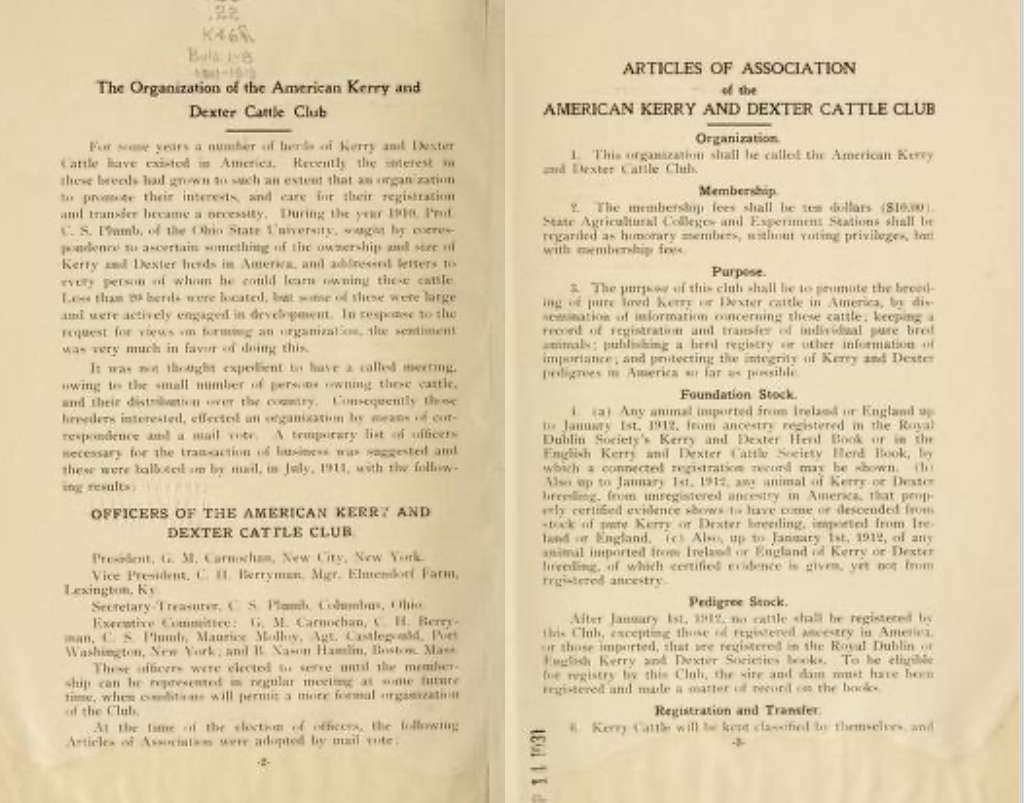
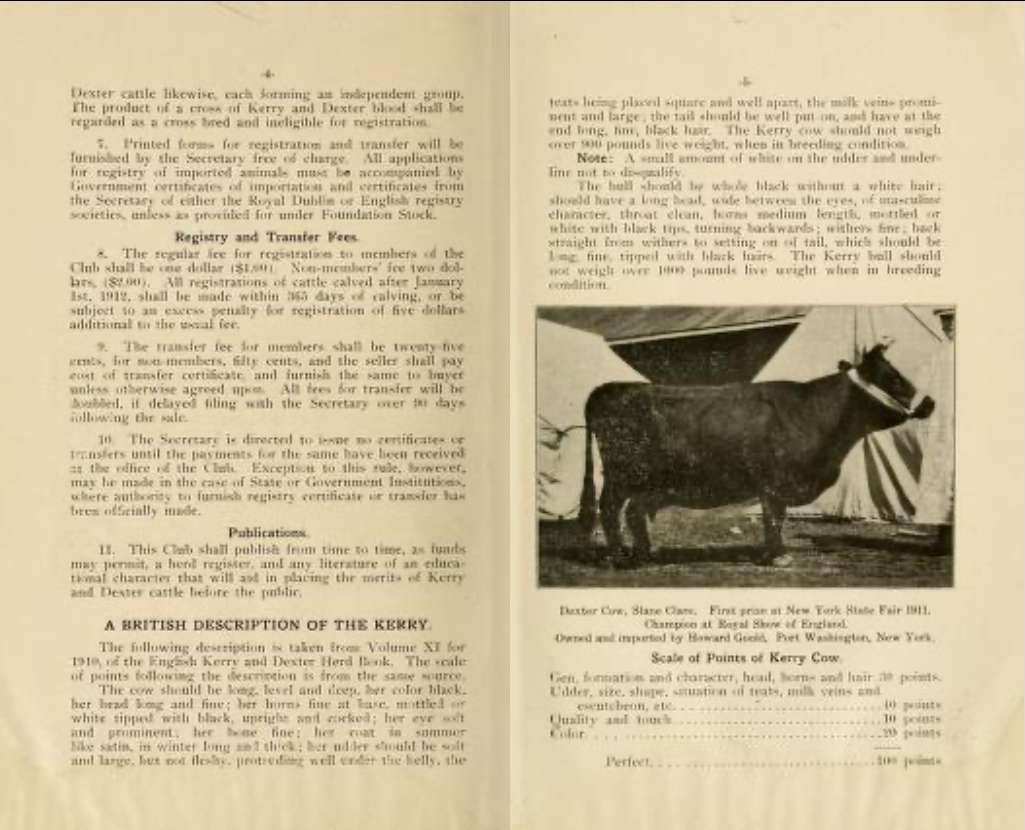

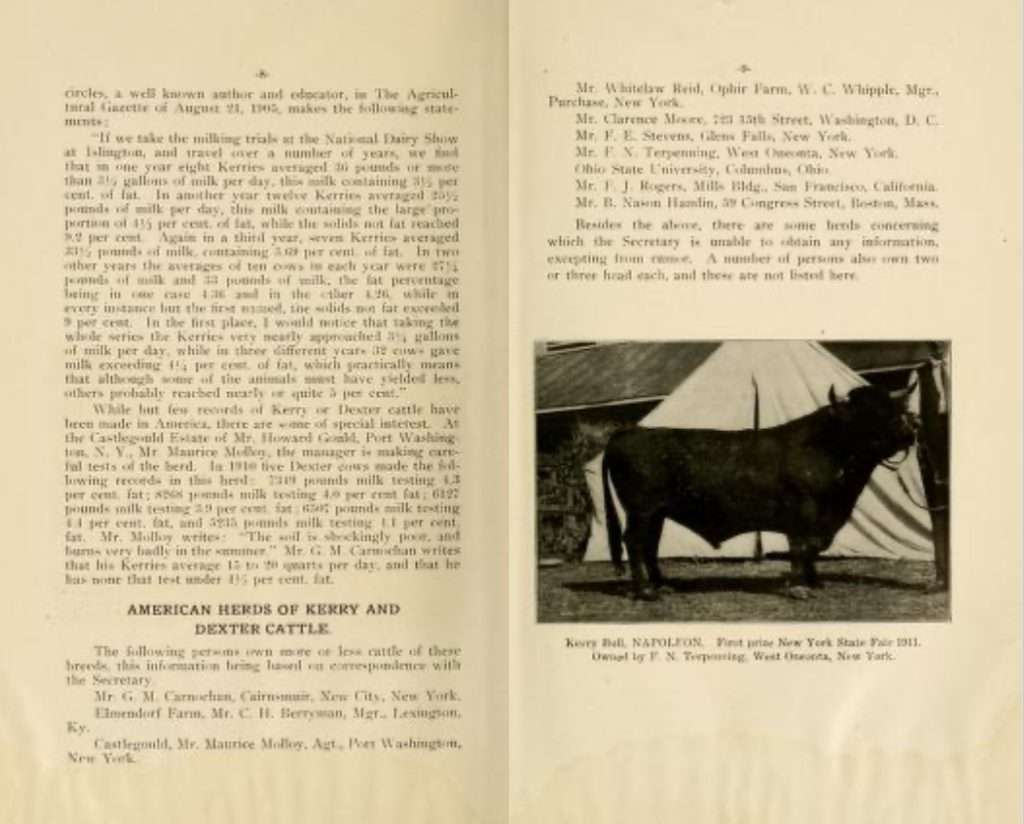
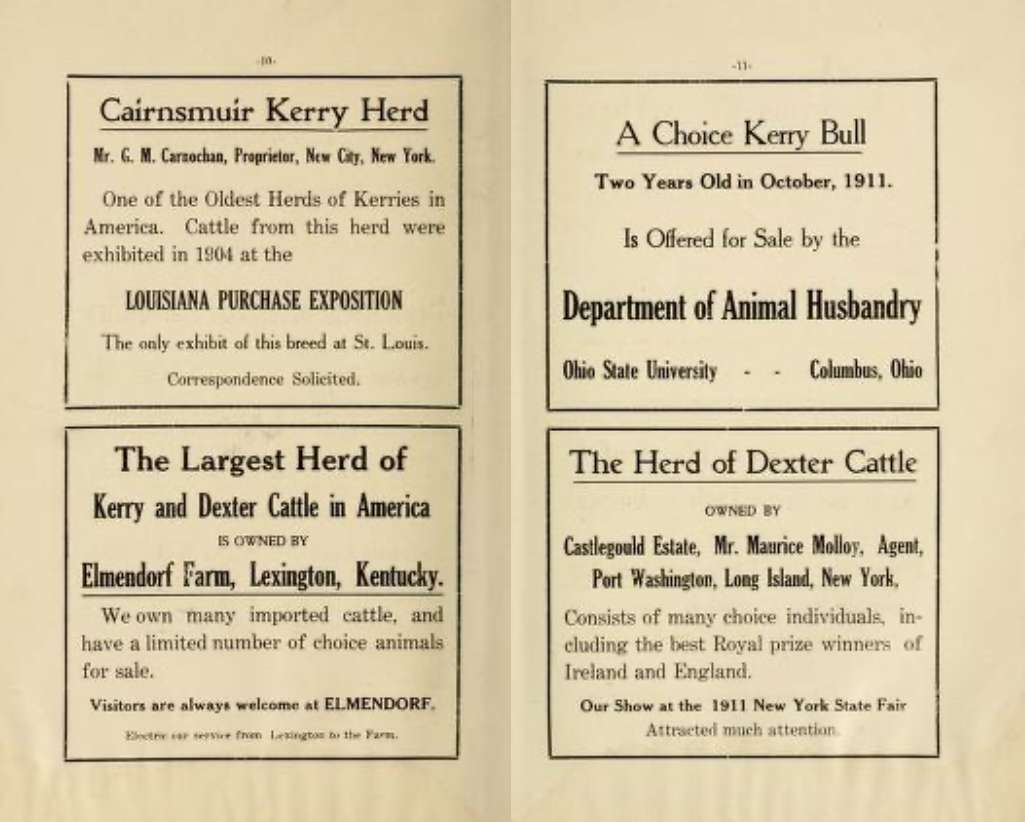
The American Kerry and Dexter Cattle Club ….series 1st Installment Read More »
Historical
Cattle expected to live outside during the winter should remain outside to adjust to the changing conditions as winter approaches.
https://extension.umn.edu/beef-cow-calf/preparing-your-cattle-severe-winter-weather
Cattle and Severe Weather Read More »
Herd Health
Now’s the time to start planning ahead. Here’s a checklist to help you plan and prepare to improve
Calf Refresher & A Checklist Read More »
Herd HealthHere is the second installment in the series of The American Kerry and Dexter Cattle Club brought to us by Judy Sponaugle of Legacy. Hope your enjoying the series!
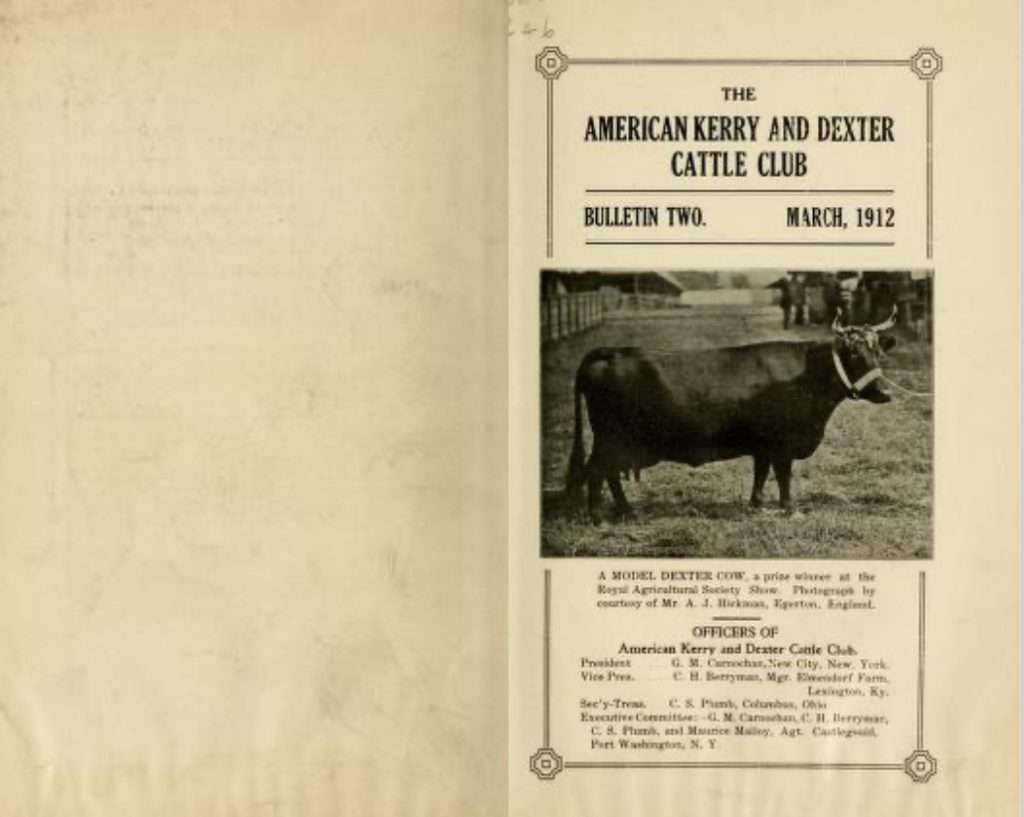
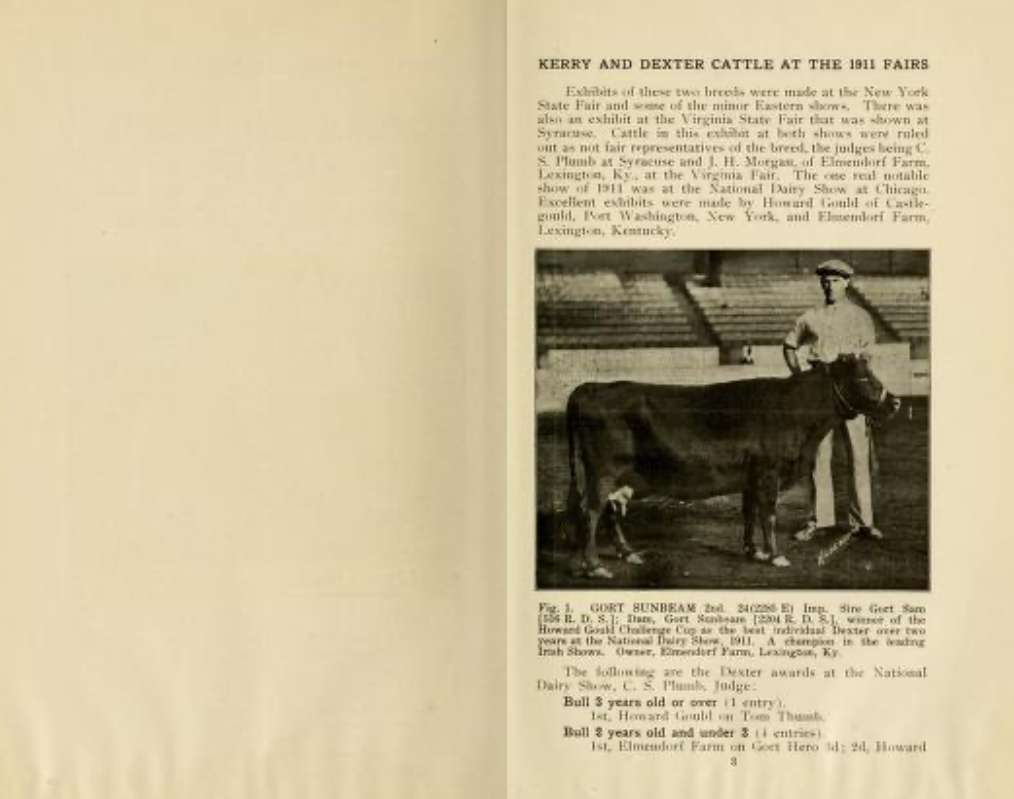
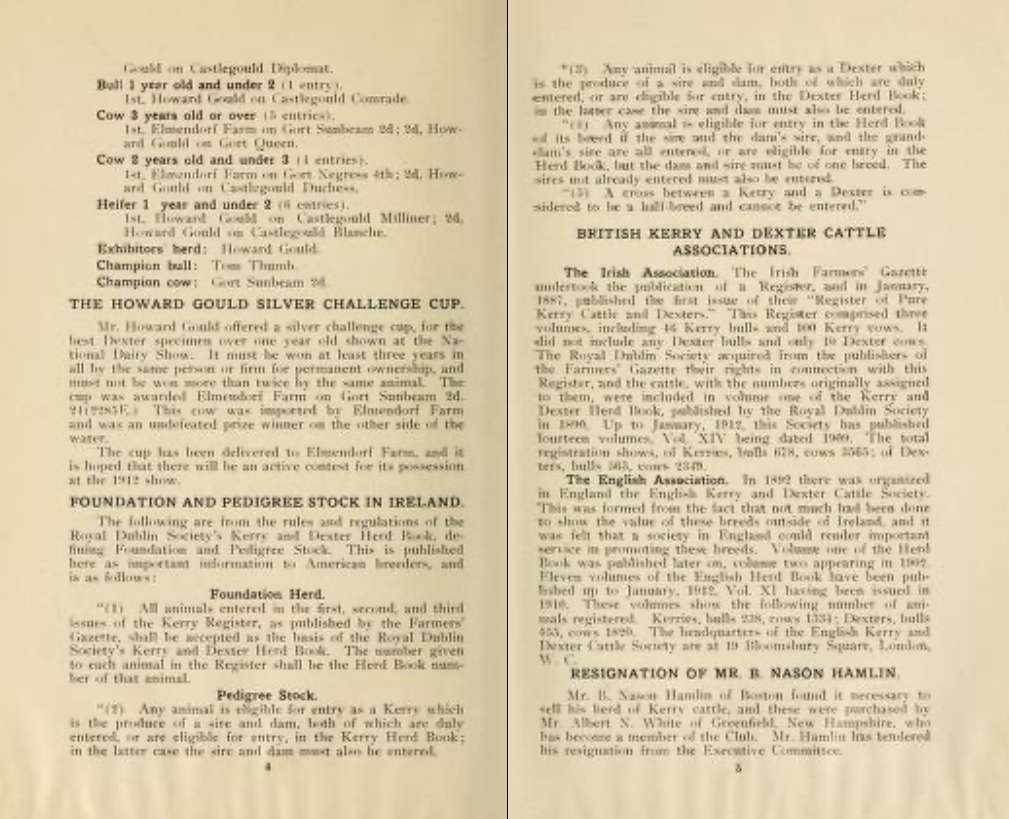
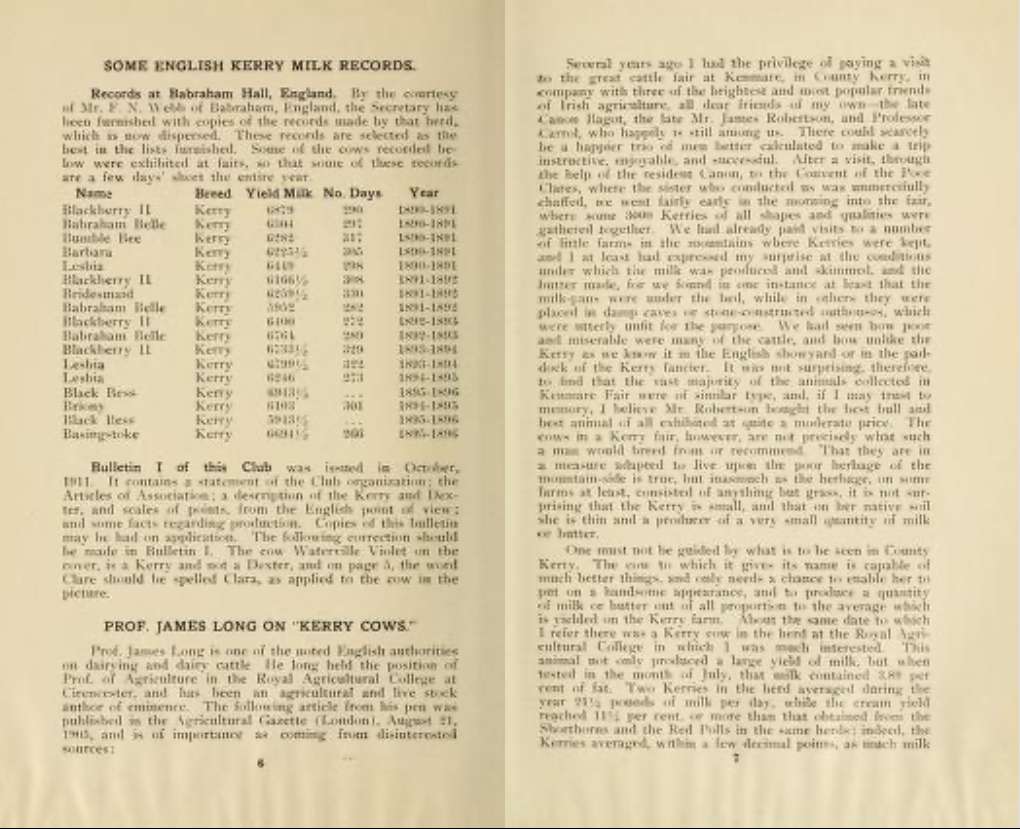
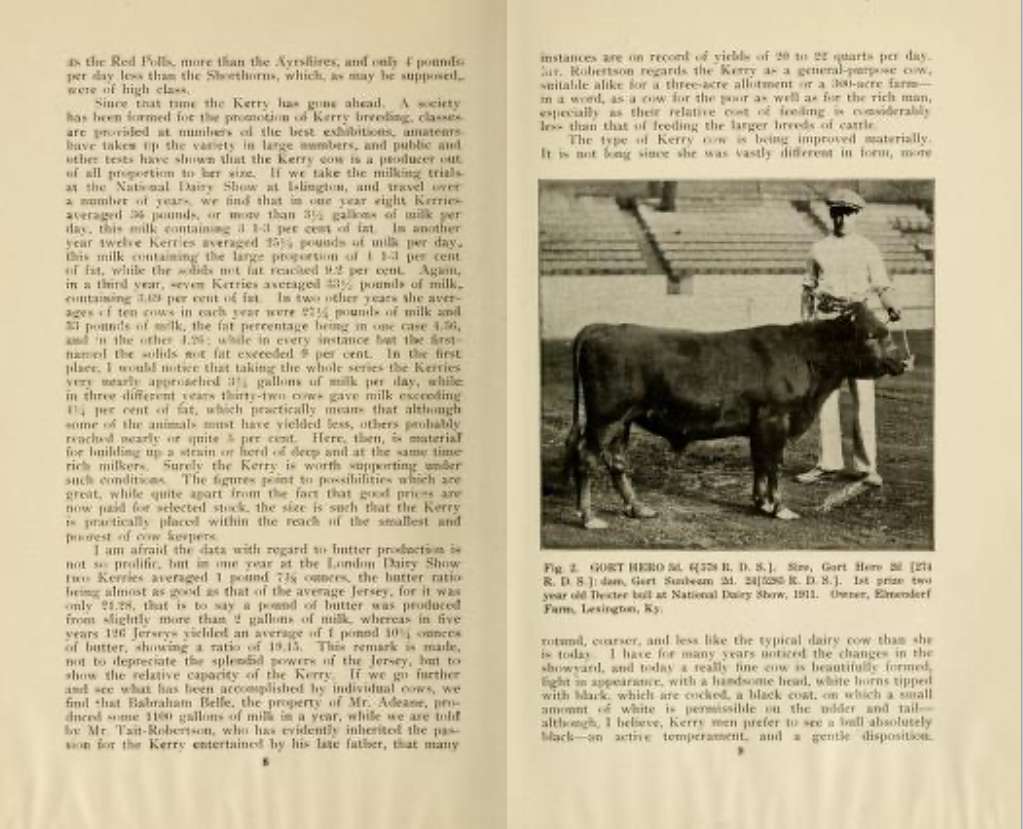
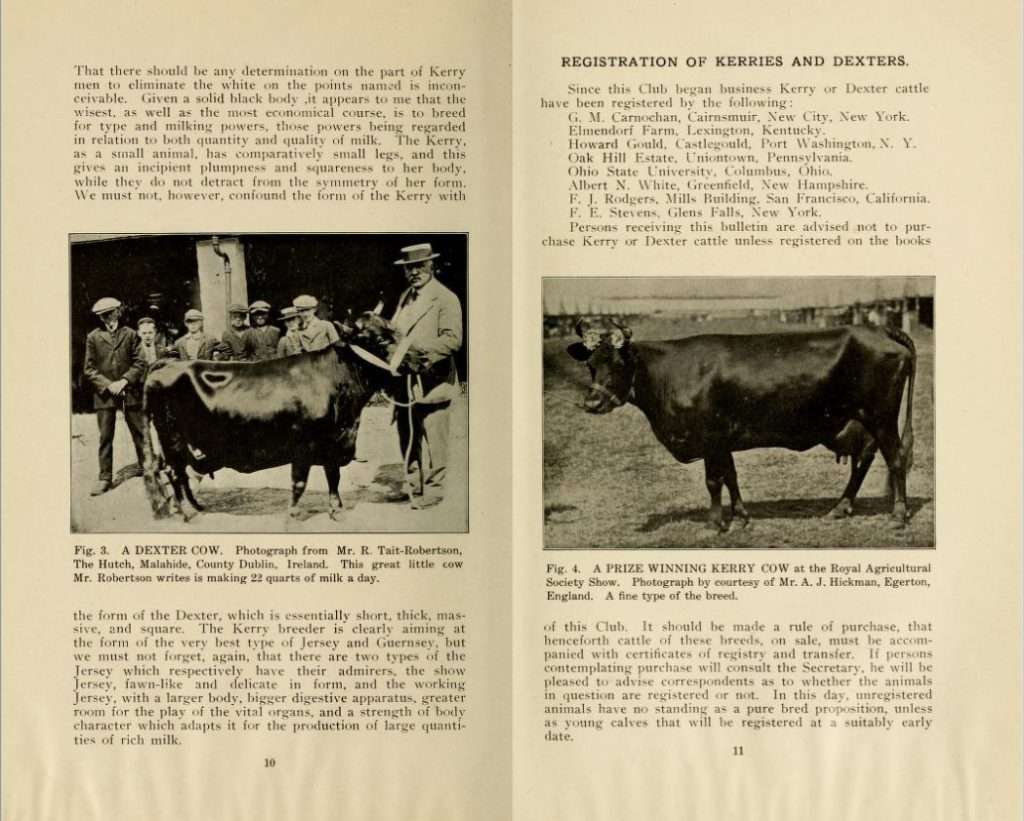
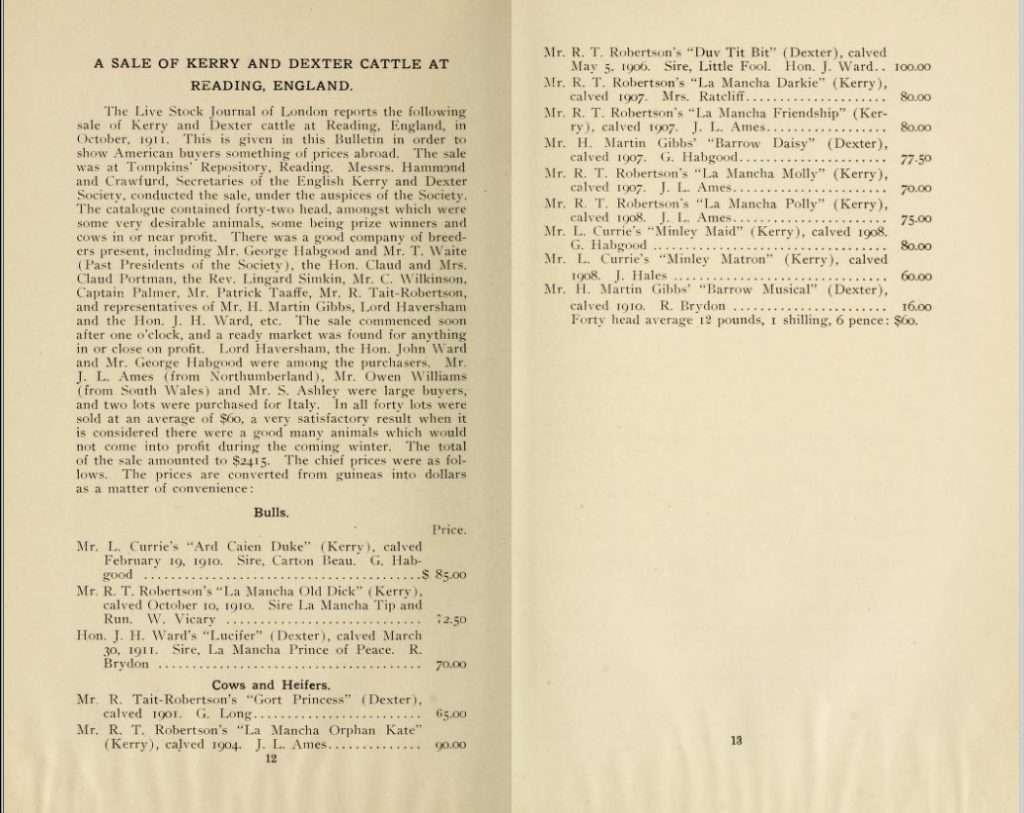
The American Kerry and Dexter Cattle Club….series 2 Installment Read More »
HistoricalHow much dairy should we put in to a Dual purpose Dexter cow. If you were to consult the English herd books they would say 40 percent for the “Bag” with the remaining percents being 15 for the “Head and neck”, 25 for the “Body, top line, under-line, ribs, setting of the tail, shortness of the leg, ect.”, 10 for “Quality and Touch” and 10 for “Colour”. So 40 points goes to the quality of the udder while 25 points gets divided up between the “Body, top line, under-line, ribs, setting of the tail, shortness of the leg, ect.”. It seems to me that in Dexters the focus today tends to fall primarily on mostly two aspects alone: shortness of leg and body type with general conformation coming in at the end. Even with 3 aspects it only accounts for 25 points for a Dexter. So there is a hyper focus on 25 % of a Dexter while the 40 percent in often neglected. The length of a cow’s leg and it’s depth are not the only traits that define a Dexter. Of course, we can’t forget the other traits that almost no one talks about, the “Head and neck”. You don’t get much meat off a head but it adds a distinct breed defining trait to a cattle type to set them apart.
It’s interesting to note that Kerry cattle that became a distinct dairy breed separated from the dual-purpose Dexter also list 40 points for the udder. The only difference is that more details are mentioned about the bag, “Udder, size, situation of teats, milk veins and escutcheon”.
Now before major concern sets in, consider that this point system is based on an ideal cow. There will always be cows in a breed that are not ideal, but the goal is to breed for the ideal cow. If you look at the 3 pictures of Kerry cattle, I will share you will see that Walton Bashful is listed as ideal and her udder is the best of the three cows shown. I’d say if an udder is ideal enough for a Kerry it can likewise be good enough for a Dexter that uses the same 40 percent system. Of course, there is no problem with having an even better udder than this cow does! The next Kerry is Valencia Eileen III. You will immediately see that she could improve on her forward attachment, but she was a Kerry all the same. The final cow is Ard Caeina Una. You will see she has some attachment issues, and you will tell that her udder is hanging lower by her hocks. The placement of her teats are too close and awkward but they were still put to use, as you will see by reading her milk record. Her yield 14,562 lbs with her butterfat at 4.33 percent. Still a valuable Kerry cow. With Dexters we need to seek generational improvement in dairy traits as Dexter’s udder points are just important as Kerry cattle, but we also need to remember that improvement is generational and culling cows with good production and butterfat won’t instantly fix a problem. It could lead us to a breed full of cows with very tight nonproductive udders just because new people think a tight looking udder is an aesthetically pleasing udder.
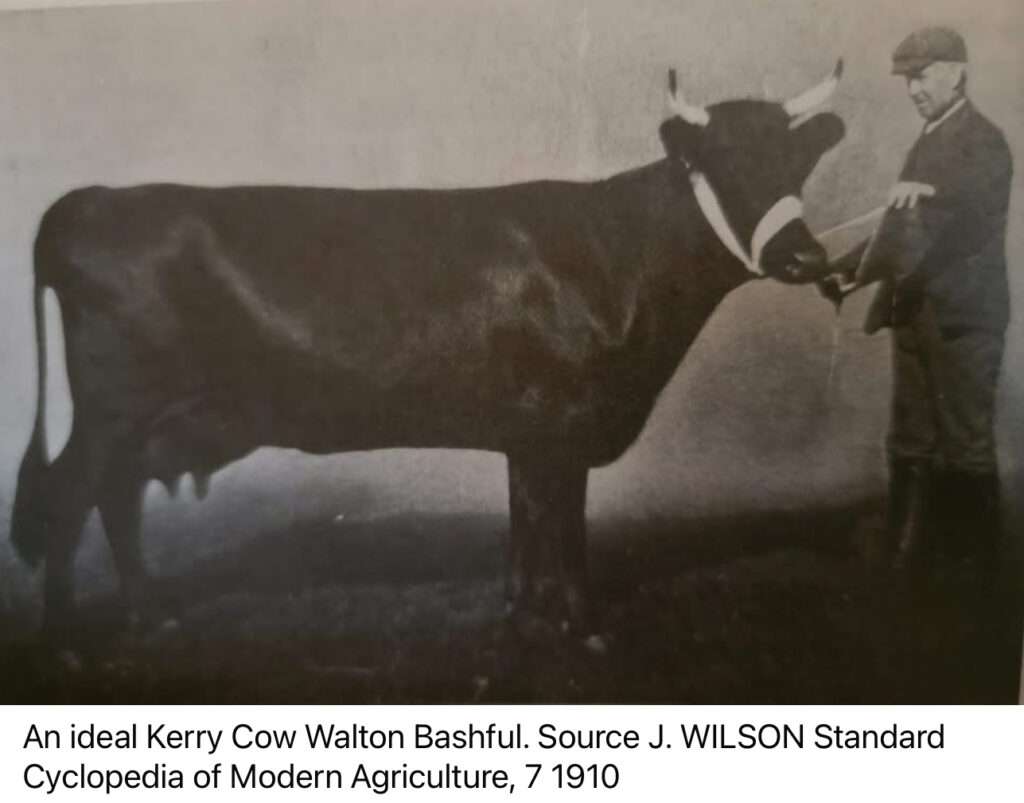
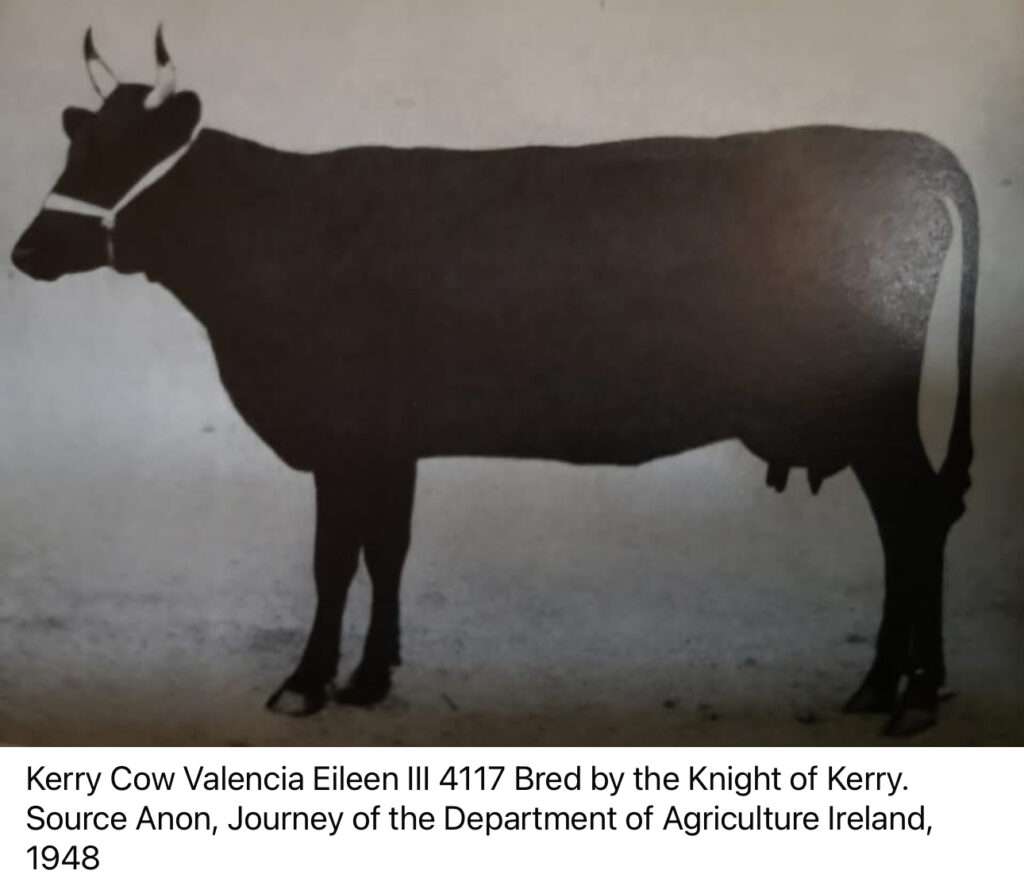
The Dual Purpose Dexter And The Kerry History Read More »
HistoricalThis the name used to describe chèvre cultured cow milk. Traditionally made chèvre is done with goat milk, but the process can be made with cow and sheep milk also. When made with sheep milk it is called brebis. We have experienced all three and love each of them. Give it a try and see what you think.
HAVE YOU EVER HEARD OF BOVRE? Read More »
Milking & DairyLegacy Dexter Cattle Registry seeks to preserve Irish Dexter bloodlines from the English upgrade/appendix registry. Support Legacy Irish Dexters by registering your Irish Dexters.
The Gift From Our Ancestor Read More »
HistoricalPreparing cattle to travel to their new home can be overwhelming. Reliable transportation, health papers, disease testing – here’s what you need to know before shipping livestock across state lines.
https://www.agproud.com/articles/61584-cattle-drives-preparing-your-livestock-for-interstate-travel#:~:text=Tagging%20along:%20Identification,before%20shipping%20recently%20sold%20livestock